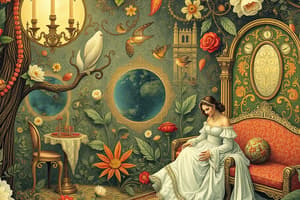Podcast
Questions and Answers
What was a significant social change in the art world during the latter half of the 20th century?
What was a significant social change in the art world during the latter half of the 20th century?
- The dominance of women artists
- The exclusion of minority artists
- The increase of artists from the middle and lower classes (correct)
- The rise of upper-class artists
What was a characteristic of Pop art?
What was a characteristic of Pop art?
- Focus on abstract expressionism
- Use of rare and exotic materials
- Rejection of technology
- Use of commonplace objects and themes from popular culture (correct)
What is a common misconception about the relationship between modern art and religion?
What is a common misconception about the relationship between modern art and religion?
- That modern art makes deep breaks from religious thought (correct)
- That modern art is only created by religious individuals
- That modern art is only concerned with aesthetics
- That modern art is deeply rooted in religious thought
What was the primary background of artists in the early 20th century?
What was the primary background of artists in the early 20th century?
What was an influence on the Pop art movement?
What was an influence on the Pop art movement?
What was a significant cultural shift in the 20th century art world?
What was a significant cultural shift in the 20th century art world?
What was a significant impact of technology on the art world in the 20th century?
What was a significant impact of technology on the art world in the 20th century?
Which artist group is known for pushing the boundaries of what art can be with AI-generated images?
Which artist group is known for pushing the boundaries of what art can be with AI-generated images?
What was a significant change in the art world in the latter half of the 20th century?
What was a significant change in the art world in the latter half of the 20th century?
What has been an important factor in urban planning and tourism due to the growth of the art world?
What has been an important factor in urban planning and tourism due to the growth of the art world?
What did Donna Haraway's A Cyborg Manifesto explore?
What did Donna Haraway's A Cyborg Manifesto explore?
What was a characteristic of the art world in the 20th century?
What was a characteristic of the art world in the 20th century?
Flashcards are hidden until you start studying
Study Notes
20th Century Artists: A Changing Landscape
The 20th century was a period of significant change in the world of art, with artists challenging traditional norms and pushing boundaries. The era saw the emergence of new movements and styles, the inclusion of previously underrepresented groups, and the rise of technological influences.
Class Background
In the early 20th century, artists typically came from privileged or upper-class backgrounds, with a few upstarts from the merchant classes. However, this began to change in the latter half of the century, as more artists from the middle and lower classes entered the art world. This shift in demographics, coupled with the inclusion of women and minority artists, has had a profound impact on the art world.
Modern Art and Religion
The relationship between modern art and religion has been a subject of much debate. While the dominant histories of modern art have often depicted it as making deep breaks from religious thought, practices, and institutions, recent scholarship has shown that these two spheres are deeply entangled. This is evident in the way modern art has been situated in religious contexts, such as churches and cathedrals.
Pop Art
Pop art was a movement that emerged in the late 1950s and 1960s, characterized by its use of commonplace objects and themes from popular culture. It was influenced by Dada, an earlier movement that ridiculed the seriousness of contemporary art and celebrated mass-produced objects. Key pop artists include Lawrence Alloway, Richard Hamilton, and Robert Rauschenberg.
Influence of Technology
The 20th century saw the rise of new technologies, which had a significant impact on the art world. Artists began to explore the potential of machines and artificial intelligence in their work. For example, Max Ernst, Wols, Emmy Bridgwater, and Richard Oelze used abstract surrealist paintings to explore the automatisms of machines. More recently, AI-generated images, such as Portrait of Edmond Belamy by the French artist group Obvious, have pushed the boundaries of what art can be.
The Role of the Curator
In the late 19th and early 20th centuries, artists were often seen as the driving force behind the art world, but this changed in the latter half of the century. Today, the role of the curator is more prominent, with curators playing a significant role in shaping the discourse of contemporary art.
Economic Impact
The art world has grown significantly since the 20th century, becoming an important economic-industrial sector with many artists, art schools, museums, foundations, galleries, curators, and collectors. This growth has also made art an important factor in urban planning and tourism.
Art and Politics
The 20th century was a period of significant political change, and many artists began to engage with political issues in their work. For example, Donna Haraway's A Cyborg Manifesto, published in 1985, explored the relationship between science, technology, and socialist-feminism.
Conclusion
The 20th century was a period of significant change in the art world, with artists challenging traditional norms, engaging with new technologies, and exploring the relationship between art and religion. While the art world has changed significantly, it continues to be a vibrant and dynamic field, with artists pushing boundaries and exploring new possibilities.
Studying That Suits You
Use AI to generate personalized quizzes and flashcards to suit your learning preferences.




